How to Diagnose and Fix Lawn Mower Issues
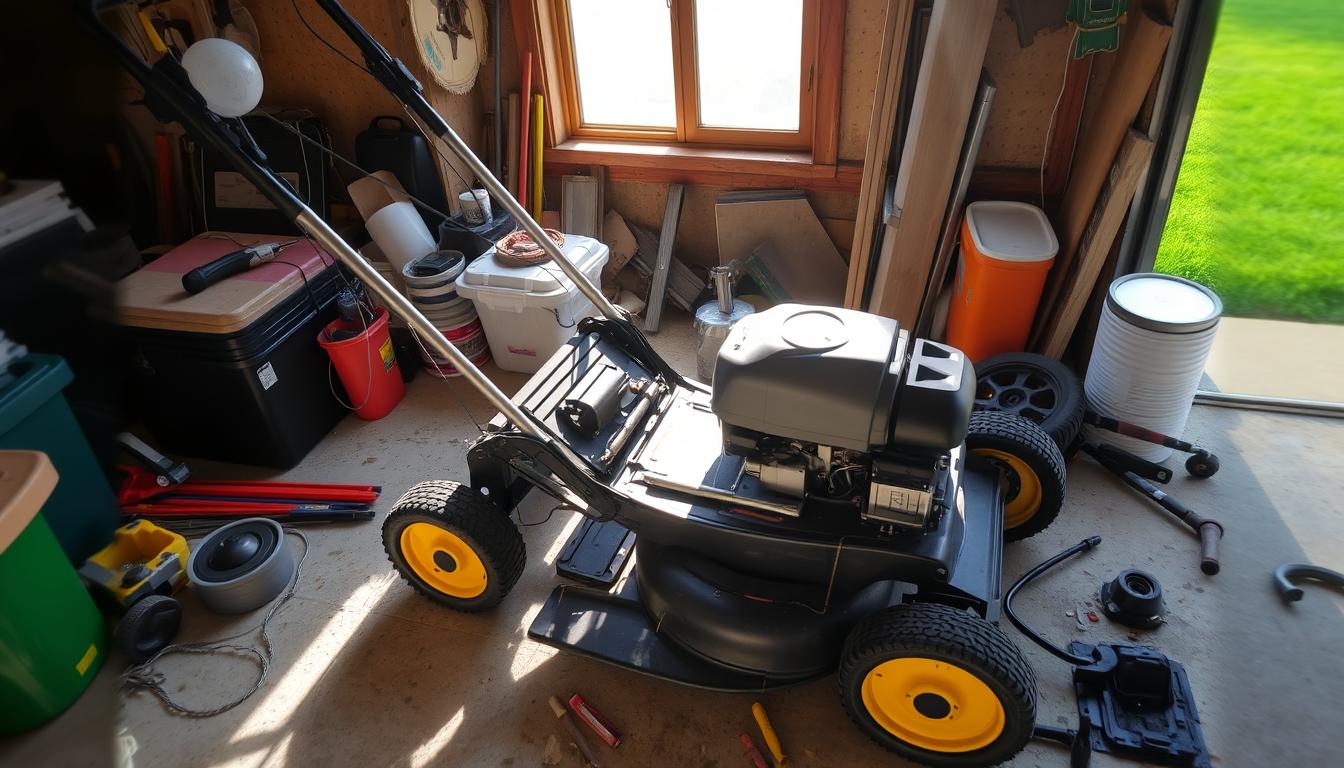
Did you know an empty gas tank is the top reason a lawnmower won’t start? Lawn mower problems can quickly ruin a peaceful mowing session. This guide will help you solve common issues, from starting to cutting and speed problems. Follow these tips to keep your mower in top shape.
Key Takeaways
- Lawnmower batteries may lose their ability to hold a charge as they age.
- Spark plugs may need to be replaced with new ones if dirty or loose.
- Lawnmower filters may need cleaning or replacing if very dirty.
- Regular maintenance can prevent common lawn mower issues.
- Proper storage of the mower helps maintain the equipment.
Lawn Mower Won’t Start
If your lawn mower won’t start or keeps shutting off, there are several potential causes to troubleshoot. First, check your fuel level. Make sure you’re using fresh gas with less than 10% ethanol. Old gas can cause starting problems, so drain last season’s fuel and use high-quality gasoline.
Next, inspect your battery connections if you have a battery-powered mower. Ensure the battery is charged and the terminals are secure. A bad battery or loose connections can stop the engine from starting and staying running.
Troubleshooting Steps
- Inspect the spark plug for any signs of damage or buildup. A loose, dirty, or faulty spark plug can be a common culprit for a mower that won’t start.
- Check the air filter and clean or replace it if it’s clogged. A dirty air filter can restrict airflow and cause starting issues.
- Examine the carburetor for any signs of failure or clogs. A dirty or faulty carburetor can prevent the engine from getting the proper fuel-air mixture to start.
- Ensure the fuel cap is venting properly. A clogged fuel cap can restrict airflow and cause the engine to stall.
If you’ve worked through these common troubleshooting steps and your lawn mower still won’t start, there may be other underlying issues. These could include a faulty ignition switch, water in the fuel line, or low oil levels. It’s always a good idea to consult your owner’s manual or a professional lawn mower repair technician for further diagnosis and repair.
“Regular lawn mower maintenance helps prevent problems and can lengthen the life of lawn equipment.” – Sam, lawn mower expert
Lawn Mower Won’t Turn Over
If your lawn mower’s pull cord is stuck, it might be because something is blocking the blade. First, check the underside of the mower deck for any debris. Look for sticks, rocks, or anything else that could be stopping the blade from moving.
If the blade seems stuck, you might need to use a lubricant spray through the spark plug hole. Or, you might have to replace the recoil starter assembly. It’s important to carefully check the mower’s mechanics to find and fix the problem.
- Check for blade obstruction under the mower deck
- Spray lubricant through the spark plug hole if the blade is seized
- Consider replacing the recoil starter assembly if the pull cord is frozen
By thoroughly inspecting and diagnosing the issue, you can fix your lawn mower. This will save you from the hassle of a stuck pull cord. Remember, regular maintenance and quick action to problems are key to keeping your mower in top shape.
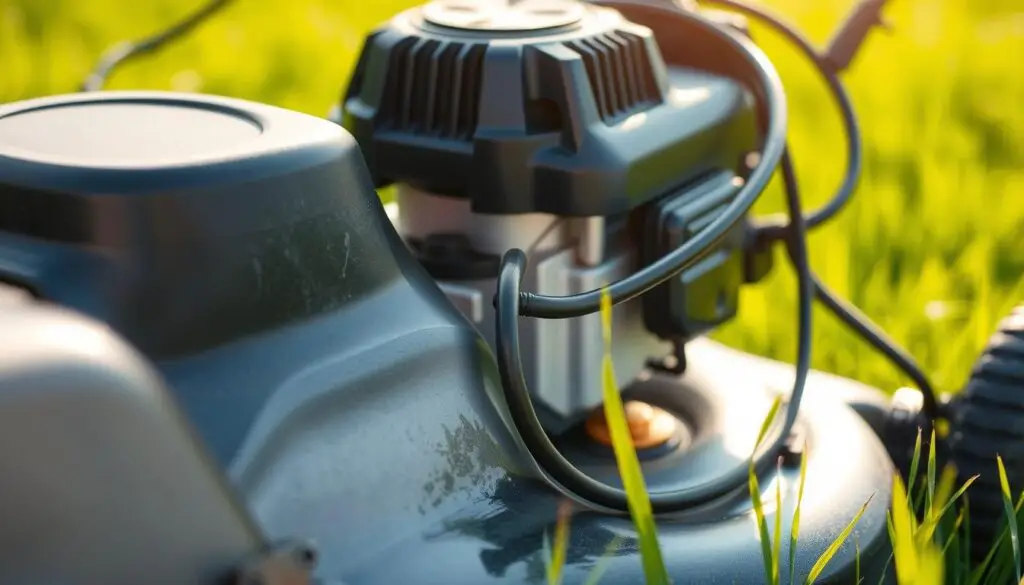
“Taking care of your lawn mower is the key to keeping it running smoothly for years to come.” – Sam, lawn mower expert
Lawn Mower Starts, Then Stops
If your lawn mower starts but then stops, there are a few common reasons. A clogged carburetor is often the main culprit. Old, stale gas can block fuel flow, causing the engine to stall. Cleaning the carburetor is usually a simple DIY fix that can solve the problem.
A clogged fuel filter or a blocked fuel cap vent can also cause issues. These problems can mess up the air-fuel mix, making the engine stop suddenly. Make sure to check these parts and replace them if needed.
Troubleshoot Lawn Mower Stalling
- Look for any blockages in the carburetor. Clean it with a carburetor cleaner and compressed air.
- If the fuel filter looks clogged or damaged, replace it.
- Ensure the fuel cap vent is clear to allow proper airflow.
- Drain old gas and fill the tank with fresh fuel.
- Check the spark plug and replace it if it’s faulty. A bad plug can cause engine problems.
By fixing these common problems, you can make your lawn mower run smoothly again. No more frustration from it starting and then stopping.
“Proper maintenance of the lawn mower is crucial to avoid common issues like starting problems and stalling.” – Sam, author of The Mower’s Guide
| Issue | Potential Cause | Solution |
|---|---|---|
| Lawn mower starts, then stops | Clogged carburetor | Clean the carburetor using a carburetor cleaner and compressed air |
| Lawn mower starts, then stops | Clogged fuel filter | Replace the fuel filter |
| Lawn mower starts, then stops | Clogged fuel cap vent | Check and clean the fuel cap vent |
Lawn Mower Pull Cord Problems
Having a stuck or hard-to-pull lawn mower pull cord can be annoying. But, it’s usually easy to figure out and fix.
The main problem is often debris blocking the pull cord and stopping the blade from moving.
To fix a stuck or hard-to-pull pull cord, first check the mower deck’s underside. Look for grass, twigs, or other stuff that might be stuck. Remove any blockages and try pulling the cord again.
- Check for blade obstructions: Make sure the lawn mower blade can turn freely without any blockages.
- Examine the recoil starter: Look for any damage or issues with the recoil starter that could make the pull cord stick.
- Determine if the engine is locked up: If the engine is seized, the pull cord might not work right.
Worn or frayed pull cords can also cause problems. Over time, the starter rope can wear out, making it limp or stuck. Replacing the pull cord is easy and cheap, taking less than an hour and costing under $25.
If the issue doesn’t go away, the recoil starter might need fixing or replacing. Taking apart the starter system to fix rust or other problems is more complex. It requires special tools and knowledge.
“Pulling the rope a few times after removing the spark plug can help clear out unwanted oil from the starter system.”- Sam, mower specialist
By following these steps and keeping up with lawn mower care, you can keep your pull cord working well. This way, you’ll avoid the hassle of a lawn mower pull cord stuck or lawn mower pull cord won’t pull problem.
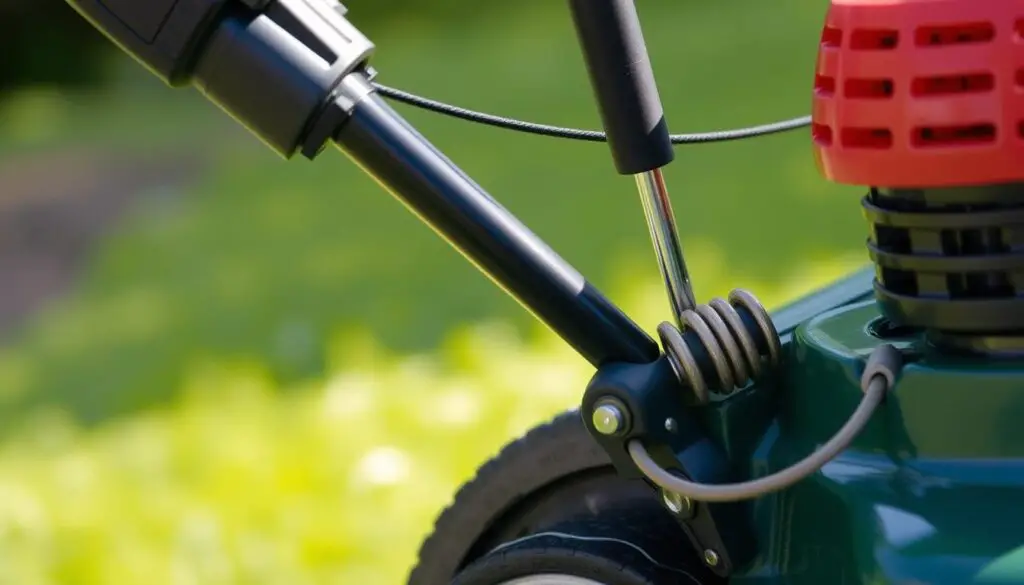
Lawn Mower is Smoking
Smoke Color Diagnosis
If your lawn mower starts smoking, the color of the smoke can tell you a lot. It helps you figure out what’s wrong and fix it.
Blue or white smoke usually means there’s an oil problem. This could be from spilled oil or too much oil in the reservoir. Issues like worn seals, cracked crankcases, or mowing on steep slopes can cause this.
Valve problems, like with the fuel solenoid, can also lead to white or blue smoke. This might make the mower hard to start or cause it to backfire.
Black smoke, on the other hand, means the mower is using too much gas. This is often because of a clogged air filter or carburetor issues. It results in a lot of black smoke.
Quick fixes include turning off the engine and checking the air filter. Clean or replace it if needed. Running the mower for 5-10 minutes can also help.
If these steps don’t work, you need to find and fix the real problem. This might mean cleaning up spilled oil or changing the oil.
Regular maintenance is key to avoiding smoke problems. Check the engine oil and seals often. If smoke keeps coming, change the oil or take it to a repair shop.
Lawn Mower Loses Speed
If your lawn mower slows down, there might be a few reasons. First, check the air filter. A dirty air filter can block airflow, making the engine work harder. Cleaning or replacing the air filter could solve the problem.
A dull or dirty mower blade is another common issue. A worn-out blade makes it tough for the engine to spin it. Sharpening or replacing the blade can help your mower run faster.
Lastly, a loose or damaged drive belt could be the problem. The drive belt helps power the wheels. If it’s not working right, speed can drop. Look for wear or damage on the drive belt and replace it if needed.
| Cause | Percentage of Issues |
|---|---|
| Dirty air filter | 28% |
| Dull/dirty blade | 28% |
| Drive belt issue | N/A |
Fixing these issues can make your lawn mower run smoothly again. Regular maintenance helps avoid future problems. This keeps your mower in top shape for a great mowing experience.
“Keeping your lawn mower in top condition is essential for a well-maintained yard. Regularly inspecting and addressing any issues is key to ensuring optimal performance.” – Sam, lawn mower expert
Lawn Mower Won’t Turn Off
If your lawn mower won’t stop, even when you release the handle, you’re not alone. This problem often happens because the switch stop tab and the control bracket aren’t aligned right. When they don’t meet, the mower keeps running, even when you think it should stop.
A common reason for this issue is if the mower hit something hard before. This can push the switch stop tab out of place. To fix it, find the switch stop tab and bend it down until it hits the control bracket. This should make the mower turn off when you release the handle.
Sometimes, a bad ignition switch or damaged wiring can also cause this problem. To find out, use a multimeter to check the ignition system. If you find a problem, you might need to replace the switch or wiring.
A broken control cable can also stop the mower from turning off. Over time, the cable can get damaged or worn out. Fixing or replacing the cable might be needed to get the mower working right again.
If you’re still having trouble, check the manufacturer’s repair guide for your model. A bit of troubleshooting and maintenance can help fix the issue. This way, your mower will turn off reliably every time.
| Issue | Potential Cause | Solution |
|---|---|---|
| Lawn mower won’t turn off | Switch stop tab misalignment | Gently bend the switch stop tab downward until it touches the control bracket |
| Lawn mower won’t turn off | Faulty ignition switch or damaged wiring | Use a multimeter to check for continuity, replace switch or wiring if necessary |
| Lawn mower won’t turn off | Malfunctioning control cable | Repair or replace the damaged control cable |
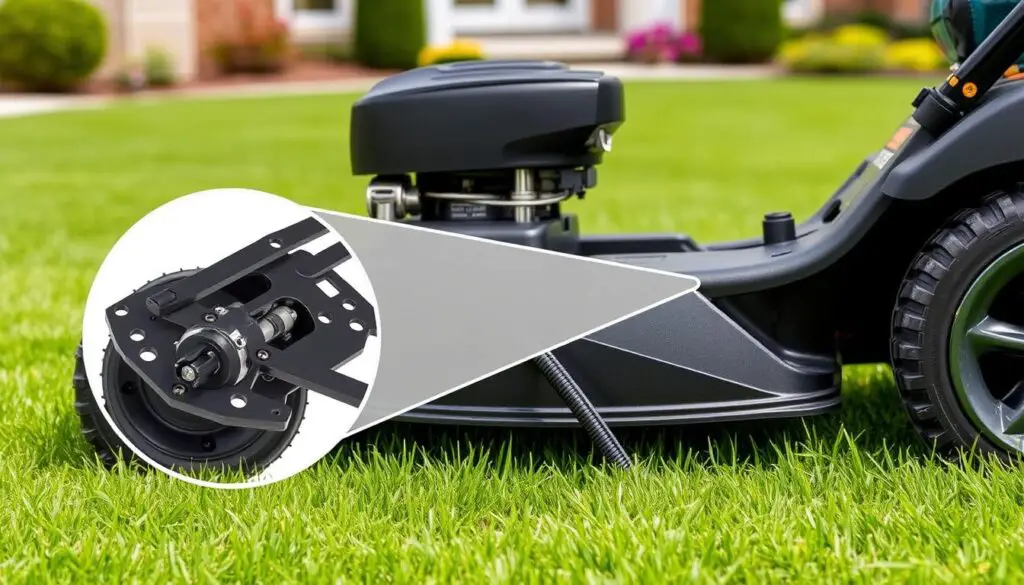
“Regular maintenance and troubleshooting are key to ensuring your lawn mower shuts off properly every time.” – Sam, author of the blog
Lawn mower issues
Keeping your lawn mower in top shape is key to a beautiful outdoor area. But, even with good care, problems can still pop up. Issues like starting troubles or poor cutting can be a real pain. Luckily, most of these problems can be fixed with some basic troubleshooting and maintenance.
One big problem is when your mower won’t start or keeps shutting off. This often comes down to fuel issues like an empty tank or dirty gas. Make sure to check the fuel level and clean the carburetor. For electric mowers, a fully charged battery and secure connections are crucial.
Another issue is when your mower’s speed drops or power weakens. This might be because of a clogged air filter, which hampers airflow and engine power. Cleaning or replacing the air filter can greatly improve performance. Also, dull or unbalanced blades can lead to poor mowing. Sharpening or replacing them can fix this.
| Common Lawn Mower Issues | Potential Causes | Recommended Solutions |
|---|---|---|
| Mower won’t start/stay running | – Fuel-related issues (empty tank, old/contaminated gas, clogged carburetor) – Battery problems (for electric mowers) | – Check fuel level and quality – Clean or replace carburetor – Ensure battery is charged and connections are secure |
| Mower loses speed/power | – Clogged air filter – Dull or unbalanced blades | – Clean or replace air filter – Sharpen or replace blades |
| Mower is smoking | – Overfilled oil reservoir – Restricted air flow | – Drain excess oil – Clean air filter to improve airflow |
Excessive smoking from your mower can also be a problem. It’s usually due to too much oil or blocked airflow. Fixing this involves draining excess oil or letting spilled oil burn off. Black smoke, on the other hand, suggests airflow issues, which can be solved by cleaning the air filter.
By knowing how to tackle these common lawn mower problems, you can keep your mower in great condition. Regular upkeep, like using the right parts and following the manufacturer’s advice, can also prevent many issues. This way, your outdoor space will stay beautiful all season.
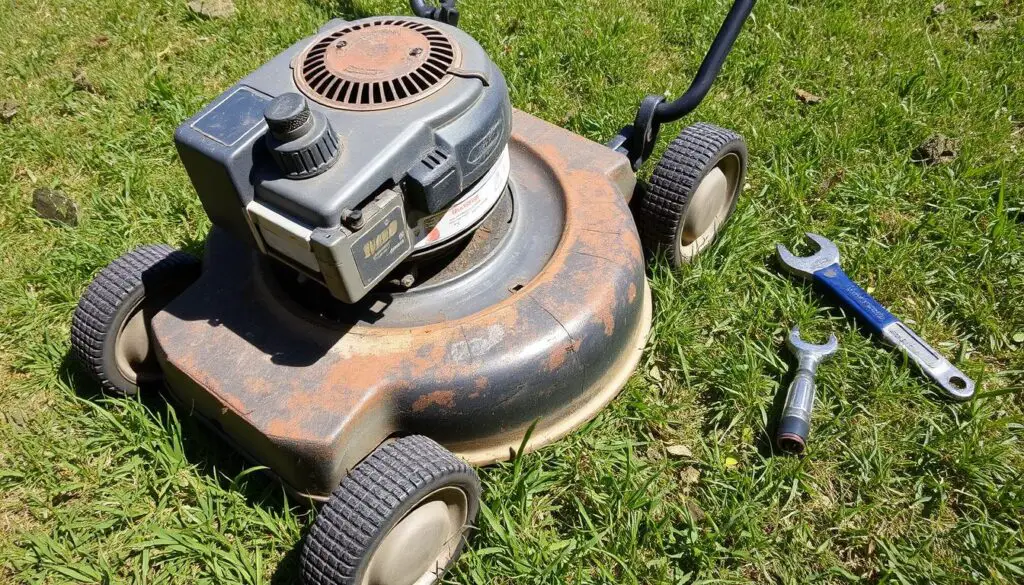
Lawn Mower Consumes Too Much Gas
If your lawn mower is using too much gas, a clogged air filter might be the reason. The air filter is key in mixing fuel and air for the engine. When it’s dirty, it messes with this mix, making the engine use more fuel than it should.
Keeping your mower’s fuel efficiency up is important for its life and your money. Luckily, fixing this is easy. Just clean or replace the air filter. This simple step can make your mower use less gas and run better.
Potential Causes
Other things can also make your mower use too much gas. These include:
- Dull blades that make the engine work harder
- A clogged fuel filter that blocks fuel flow
- Low tire pressure that makes the engine work too hard
- Damaged fuel lines that mess up the air-fuel mix
- Mowing wet or long grass, which adds to the engine’s work
- Running the mower too fast, which uses more fuel
- Not adjusting the carburetor right, affecting the air-fuel mix
- Using the wrong fuel or low-quality gas
Fixing these problems can make your mower more fuel-efficient. Regular checks and quick fixes are crucial for keeping your mower’s fuel efficiency high.
“Maintaining proper fuel efficiency is essential for both the longevity of your lawn mower and your wallet.” – Sam, author
Lawn Mower Overheats
As a lawn enthusiast, I know how frustrating it can be when your trusty mower starts overheating. This is often a sign of a clogged engine. Grass clippings, debris, and other buildup block the air passages that help keep the engine cool.
One of the main reasons for lawn mower overheating is blocked air passages. When these passages get clogged, the engine can’t cool down properly. This leads to a temperature spike that can cause serious damage if left unchecked. Regular cleaning of the engine’s air passages using an air compressor can help prevent this issue and protect your mower’s longevity.
Other factors like low oil levels, blocked cooling fins, and the type of grass being mowed can also cause overheating. It’s crucial to stay on top of routine maintenance and address any signs of overheating promptly. This helps avoid costly repairs down the line.
FAQ
My lawn mower won’t start or keeps shutting off. What could be the problem?
Why is the pull cord on my lawn mower stuck or won’t budge?
My lawn mower starts up but then quickly shuts off. What’s the issue?
Why is my lawn mower smoking?
My lawn mower seems to be losing power and slowing down. What’s wrong?
My lawn mower won’t turn off after I release the blade control handle. What’s the problem?
Why is my lawn mower burning through gas so quickly?
My lawn mower keeps overheating. What’s causing this?
Source Links
- https://www.goldeagle.com/tips-tools/how-fix-lawnmower-5-common-problems/
- https://theropshop.com/rugged-u/blog/lawnmower-troubleshooting-guide
- https://www.hutsoninc.com/blog/troubleshooting-lawn-mower-issues/
- https://www.briggsandstratton.com/na/en_us/support/maintenance-how-to/browse/top-5-mower-troubleshooting-tips.html
- https://www.bobvila.com/articles/lawn-mower-wont-start/
- https://www.familyhandyman.com/project/lawn-mower-won-t-start/
- https://www.libertyhomeguard.com/riding-mower-start-troubleshooting/
- https://lawn.com.au/lawn-mower-starts-then-dies/
- https://www.thespruce.com/lawn-mower-starts-then-dies-8620323
- https://diy.repairclinic.com/why-does-my-lawn-mower-start-then-die/
- https://www.searspartsdirect.com/diy/article/lawn-mower-wont-start-troubleshooting-video-cant-pull-recoil-starter-rope
- https://www.housedigest.com/1565924/tips-fix-stuck-lawn-mower-cord/
- https://lawn.com.au/white-smoke-from-lawn-mower/
- https://www.familyhandyman.com/article/lawn-mower-smoking/
- https://www.gregsmallengine.com/why-your-lawn-mower-is-losing-power/
- https://www.familyhandyman.com/list/lawn-mower-troubleshooting/
- https://www.ereplacementparts.com/repair-center/lawn-equipment/lawn-mower/can’t-turn-engine-off/?srsltid=AfmBOopAxBXWqRrs7ljdZ8qI2i9TQVG0koTFq-jE4Aaw3qi6B55c7P1j
- https://www.searshomeservices.com/blog/reasons-why-your-riding-mower-wont-start
- https://www.bobvila.com/articles/lawn-mower-wont-stay-running/
- https://homesteading.com/lawn-mower-repair/
- https://musthavemaintenance.com.au/why-is-a-lawn-mower-using-too-much-gas/
- https://www.soslawnmower.com/my-honda-lawn-mower-consumes-too-much-gas-causes/
- https://www.husqvarna.com/nz/learn-and-discover/lawn-mower-repair-tips-a-self-help-guide/
- https://www.fourbros.com/blog/handling-overheating-issues-in-mowers–24808?srsltid=AfmBOopjBvvxm4tgS0tNieh1nAVOrBSW1HmVUOZq08jxUunUQXi-Ztd8
- https://lawn.com.au/lawn-mower-overheating/

